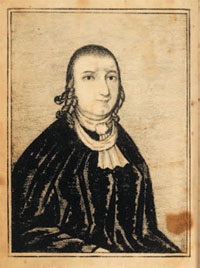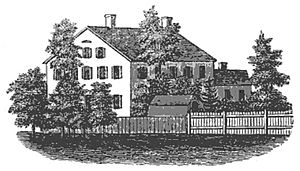Public Universal Friend facts for kids
Quick facts for kids
Public Universal Friend
|
|
|---|---|

Portrait from David Hudson's 1821 biography
|
|
| Born |
Jemima Wilkinson
November 29, 1752 |
| Died | July 1, 1819 (aged 66) |
| Nationality | American |
| Occupation | Preacher |
The Public Universal Friend (born Jemima Wilkinson; November 29, 1752 – July 1, 1819) was an American preacher. The Friend was born in Cumberland, Rhode Island, to Quaker parents. After a serious illness in 1776, the Friend said that Jemima Wilkinson had died. A new spirit, sent by God, had taken over the body. This new spirit was called the Public Universal Friend.
From then on, the Friend did not use the birth name Jemima Wilkinson. The Friend also chose not to use male or female pronouns. Dressed in clothes that looked neither fully male nor female, the Friend traveled and preached. Many people followed the Friend, forming a group called the Society of Universal Friends.
The Friend's teachings were much like those of other Quakers. The Friend believed in free will and was against slavery. Many strong followers were unmarried women. They took on important roles in their homes and community. In the 1790s, the Society bought land in Western New York. There, they started a town called Jerusalem. The Society of Universal Friends ended around the 1860s. Today, some people see the Friend as a pioneer for women's rights. Others view the Friend as a significant figure in trans history.
Contents
Early life and family
Jemima Wilkinson was born on November 29, 1752. This was in Cumberland, Rhode Island. Jemima was the eighth child of Amy and Jeremiah Wilkinson. The family had lived in America for four generations. Jemima was named after a daughter of Job from the Bible.
Jemima's great-grandfather, Lawrence Wilkinson, was an army officer. He came from England around 1650. He was active in the government of the colony. Jeremiah Wilkinson, Jemima's father, was a cousin of Stephen Hopkins. Stephen Hopkins was a governor and signed the Declaration of Independence. Jeremiah attended meetings with the Society of Friends (Quakers). Jemima's mother, Amy, died in 1764 when Jemima was about 12 or 13.
Jemima Wilkinson had dark hair and eyes. From a young age, Jemima was strong and good at sports. Jemima was a skilled rider and loved horses. The Friend always made sure animals were well cared for. Jemima was also a keen reader. The Friend could remember and quote long parts of the Bible.
In the mid-1770s, Jemima Wilkinson started going to meetings with New Light Baptists. These groups focused on personal religious experiences. Jemima stopped attending Quaker meetings. Because of this, the Quakers removed Jemima from their group in 1776. Jemima's sister Patience was also removed for a family matter. Two brothers, Stephen and Jeptha, were removed for training for military service. This was during the American Revolutionary War. These family and war events caused much stress for Jemima in 1776.
Becoming the Public Universal Friend
In October 1776, Jemima Wilkinson became very sick. It was likely typhus, a disease with high fever. Jemima was in bed and close to death. The family called a doctor, and neighbors watched over Jemima. After several days, the fever broke.
The Friend later said that Jemima Wilkinson had died. The Friend reported receiving messages from God through two archangels. They said there was "Room, Room, Room, in the many Mansions of eternal glory for Thee and for everyone". The Friend said that Jemima Wilkinson's soul went to heaven. Then, the body was brought back to life with a new spirit. This spirit was sent by God to preach. This new spirit was called the "Publick Universal Friend". The name came from a Bible verse, Isaiah 62:2. It also referred to "Public Friends," who were Quakers who traveled to preach. Some people at the time believed Wilkinson truly died and came back to life. Others thought the illness was faked. But the doctor and witnesses said the illness was real.
From that time on, the person formerly known as Jemima Wilkinson refused to use that name. The Friend ignored or corrected anyone who used it. When asked if that was the person's name, the Friend would quote Luke 23:3 from the Bible. The Friend identified as neither male nor female. The Friend asked people not to use male or female pronouns. Followers respected this. They used "the Public Universal Friend" or "the Friend." Some even avoided gender pronouns in their private writings.
The Friend wore clothes that looked gender-neutral or masculine. These were long, loose robes, usually black. The Friend wore a white or purple scarf around the neck, like men did. The Friend did not wear a hair-cap indoors, as women did. Outdoors, the Friend wore wide-brimmed beaver hats, like Quaker men. People described the Friend's voice differently. Some said it was "clear and harmonious." Others said it was "grum and shrill." The Friend was said to move easily and gracefully.
Beliefs and the Society of Universal Friends
The Friend began traveling and preaching. The Friend visited Rhode Island, Connecticut, Massachusetts, and Pennsylvania. The Friend's brother Stephen and sisters Deborah, Elizabeth, Marcy, and Patience joined. All of them were removed from the Quaker Society. At first, the Public Universal Friend preached that people needed to stop sinning. They needed to be saved before a coming Day of Judgment. The Friend predicted that some Bible prophecies would begin around April 1780. The New England's Dark Day in May 1780 was seen as a sign of this.
The Friend did not bring a Bible to meetings. Meetings were held outdoors or in borrowed buildings. But the Friend preached long parts of the Bible from memory. Many people came to these meetings. Some formed a group called "Universal Friends." This made the Friend the first American to start a religious community. Most followers were under 40. There were about equal numbers of women and men. Most came from Quaker backgrounds. However, mainstream Quakers did not approve of their members attending these meetings.
Newspapers wrote about the Friend's sermons by the mid-1780s. Some newspapers were very critical. They caused crowds to gather outside places where the Friend stayed or spoke in 1788. Most papers focused on the Friend's gender, not the teachings. The Friend's beliefs were very similar to those of most Quakers. One person who heard the Friend in 1788 said the teachings were "common among preachers" in Quaker churches. The Universal Friends also used language like the Quakers. They used thee and thou instead of you.
The Public Universal Friend did not believe in predestination. This is the idea that God has already decided who will be saved. The Friend taught that anyone could connect with God. God spoke directly to individuals. People had free will to choose how to act and believe. The Friend also believed that everyone could be saved. The Friend called for an end to slavery. The Friend convinced followers who owned enslaved people to free them. Several Black members were part of the Universal Friends. They helped witness the freedom papers.
The Friend taught humility and kindness to everyone. Religious meetings were open to the public. The Friend housed and fed visitors, even those who were just curious. The Friend also had good relationships with Indigenous people. The Friend owned few personal items. These were mostly gifts from followers. The Friend never owned land personally, only in trust for the community.
The Friend did not favor marriage. However, the Friend did not say that people had to remain unmarried. Most followers did marry. But more followers chose not to marry than the average at that time. The preacher also believed that women should "obey God rather than men." About four dozen unmarried women were very committed followers. They were called the Faithful Sisterhood. They took on important roles often held by men. In the Society's settlements, 20% of homes were led by women. This was much higher than in other areas.
Around 1785, the Friend met Sarah and Abraham Richards. Their marriage ended when Abraham died in 1786. Sarah and her baby daughter moved in with the Friend. Sarah adopted a similar style of hair, dress, and manners. She became known as Sarah Friend. The Friend trusted Sarah to hold the Society's property. The Friend also sent her to preach in other areas. Sarah helped plan and build the house where she and the preacher lived in Jerusalem. When Sarah died in 1793, she left her child in the Friend's care.
In October 1794, the Friend and followers met with Thomas Morris. This was in Canandaigua. They were invited by Timothy Pickering. The Friend went with Pickering to talks with the Iroquois people. These talks led to the Treaty of Canandaigua. With permission and an interpreter, the Friend spoke to US officials and Iroquois chiefs. The speech was about "the Importance of Peace & Love." The Iroquois liked the speech.
Later life and legacy
The Public Universal Friend's health began to get worse after 1800. By 1816, the Friend suffered from painful swelling. But the Friend continued to see visitors and give sermons. The Friend gave a last regular sermon in November 1818. The last time the Friend preached was at the funeral of sister Patience Wilkinson Potter in April 1819.
The Friend died on July 1, 1819. The community's death book recorded the exact time. As the Friend wished, there was no funeral service, only a regular meeting. The body was placed in a coffin with a glass window. It was buried four days later in a stone vault in the cellar of the Friend's house. Years later, the coffin was moved. It was buried in an unmarked grave, as the preacher preferred. News of the Friend's death appeared in newspapers across the eastern United States.
Close followers remained loyal. But as they died, the group's numbers decreased. The Society struggled to attract new members. The Society of Universal Friends ended by the 1860s.
The Friend's Home and its temporary burial place are in Jerusalem, New York. It is listed on the National Register of Historic Places. It is thought to be near the birthplace of Seneca chief Red Jacket. The Yates County Genealogical and Historical Society's museums in Penn Yan have items from the Friend. These include a portrait, Bible, carriage, hat, and documents. As late as the 1900s, people in Little Rest, Rhode Island, called a type of solidago plant Jemima weed. This was because it appeared when the preacher first visited the area in the 1770s.
The Friend and followers were pioneers in the area between Seneca and Keuka lakes. The Society of Universal Friends built a grain mill in Dresden.
See also
- Mother Ann Lee, a leader of the Shakers, a religious group from the same time
- Jennie June, a transgender person also from a religious family in New England



